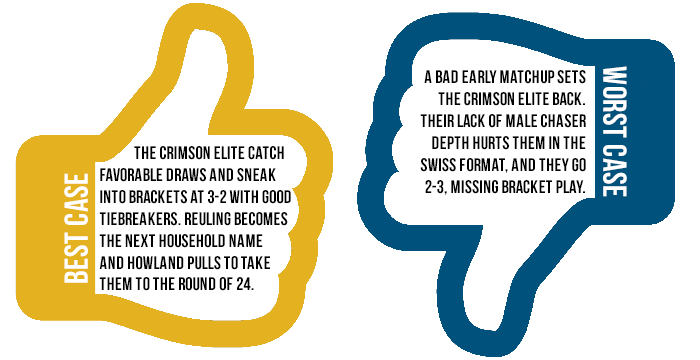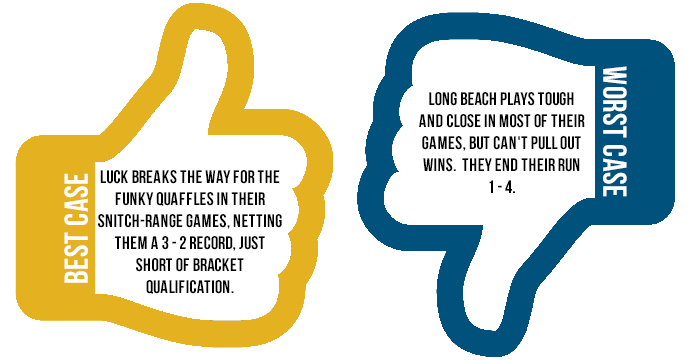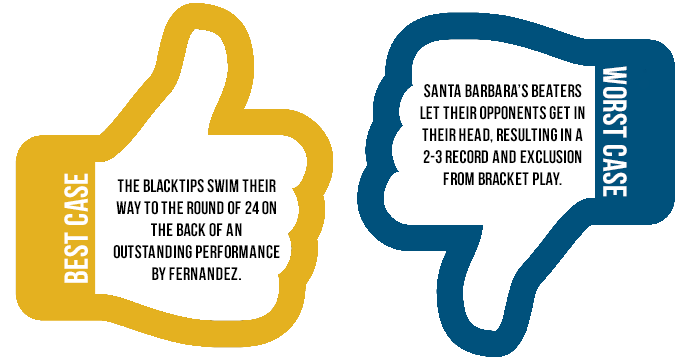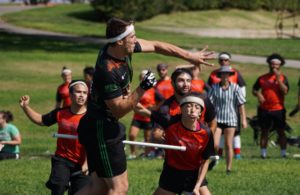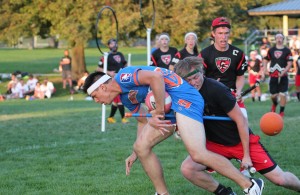- Rule, Britannia, no more?
- Unpopular Opinions: US Quadball Cup 2023
- Proven Contenders: University of Virginia
- Proven Contenders: Rutgers University
- Proven Contenders: University of Michigan
- Proven Contenders: Creighton University
- Different Perspectives: A Look Inside USA Ultimate
- Antwerp QC, Much of Belgian Core, Leaves Competitive Quidditch
Part XIV
- Updated: March 2, 2015
Rock Hill Roll Call is your in-depth guide to the 80 teams that will compete for the title of World Cup 8 Champion. We’ve reached out to writers and analysts all over the country to bring you the lineups, strategies, focal points and aspirations of each and every attending team. Whether you are looking for a leg up on the competition or just want a detailed preview of the sport’s main event, this is the place for you.
 By Kevin Oelze
By Kevin Oelze
What the University of Utah’s Crimson Elite do not boast in male chaser depth, they makes up for in sheer intelligence. The team played with just three male chasers (plus seeker Dan Howland) at the West Regional Championship, and it succeeded not with a deep chaser line but by masterfully controlling the pace of the game.
Unlike many teams that play a consistently slow, calculated offense, the Crimson Elite are able to change the pace to their liking depending on the situation. They can play slowly and deliberately with plenty of resets when they’re attempting to regain bludger control, or they can speed up the game and try to turn up the scoring once they have control. If they can appropriately manipulate the pace of the game and limit possessions against better teams, it can hang with just about anyone.
Beyond the Crimson Elite’s pacing strategy, the team’s best player, beater Ben Reuling, looks like he could compete for the title of best male beater in the sport when he’s on form. Not only does his size make him physically imposing, but he has a cannon of an arm and strong ball skills. With or without a bludger, Reuling can assert himself on the pitch with his physical dominance.
The Crimson Elite’s female chasers are also very solid and provide strong scoring threats–a necessity for top teams. Finally, their seeker, Dan Howland, was undefeated in SWIM situations at the West Regional, as his incredible wingspan allows him to get around the more physical snitches to make the grab.
Overall, despite lacking in male chaser depth, this team has a suite of talented players, and it knows how to use them.
 By Anonymous
By Anonymous
With an impressive run at the West Regional Championship, the Crimson Elite took home some notable victories against UCLA, Arizona State University and Arizona Quidditch Club with snitch grabs. Howland finished the weekend with several clutch snags and never failed in SWIM situations, marking him as perhaps the most underrated seeker in the region. He performs especially well in high-pressure tournaments such as World Cup and regionals. During his rookie season last year, Howland had a 3-1 snitch-catch record in pool play at World Cup VII, only coming up short against eventual runner-up Texas State University.
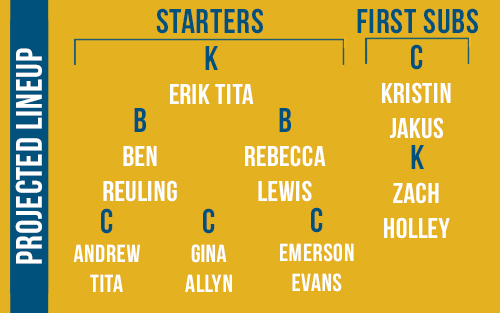 But Crimson’s successful seeking game can be attributed in part to the squad’s overpowering beating corps. Led by captain Reuling, Crimson’s beaters are physical and deceptively quick. With plenty of depth at both male and female beater, the team is able to easily sustain its aggressive beating style and control the pitch for an entire match.
But Crimson’s successful seeking game can be attributed in part to the squad’s overpowering beating corps. Led by captain Reuling, Crimson’s beaters are physical and deceptively quick. With plenty of depth at both male and female beater, the team is able to easily sustain its aggressive beating style and control the pitch for an entire match.
It’s difficult to pinpoint a weakness on Crimson’s well-rounded squad. Its experienced female chasers are all top contributors; in fact, it’s the team’s male chaser depth that is perhaps the most lacking. But with hardly any drop-off in talent in Crimson’s second string, its male chasers are more than capable of standing their ground against formidable opponents.
As seen at the West Regional, the only reliable way to beat the Crimson Elite is out of snitch range. But pulling out of range against Crimson is a struggle for even top-tier teams. The Utah squad’s only loss at the West Regional came 120*-40 in the semifinals against the heavily-favored LA Gambits, which struggled most of the game to pull out of range. To beat a well-rounded team like the Crimson Elite, you will have to find a way to put a lot of points on the board against its stiff defense before the snitch emerges. If you can stop Crimson from getting its trademark early leads and keep Howland from pulling a game-winning snitch, you have a good chance to beat one of the best teams in the West.
 By Steve DiCarlo
By Steve DiCarlo
The Long Beach Funky Quaffles have always been known in the West for their exceptional recruitment, and this season was no different. A number of impressive yet unfamiliar athletes have been added to their roster each tournament, and their performance in Rock Hill will depend on how often they can get these newcomers to practice between now and April.
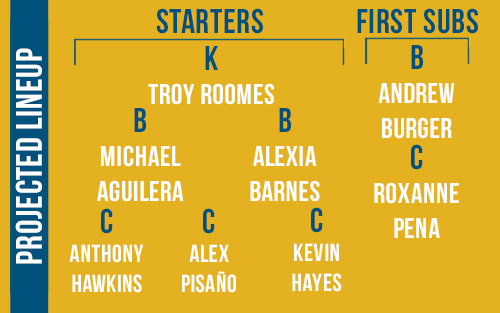 Long Beach’s season started out with panic, as a large majority of the players who helped this Pot 5 team advance to bracket play in World Cup VII left the squad to join the LA Gambits. The Funky Quaffles managed to find replacements in Kyle Loud, the hulking Troy Roomes and former University of South Florida beater Alexia Barnes, but not all of the team’s newest athletes demonstrate the dedication that its old stars used to show. The lack of chemistry between veterans who practice together several times a week and the team’s newcomers–some of whom rarely play outside of tournaments–is evident on the pitch.
Long Beach’s season started out with panic, as a large majority of the players who helped this Pot 5 team advance to bracket play in World Cup VII left the squad to join the LA Gambits. The Funky Quaffles managed to find replacements in Kyle Loud, the hulking Troy Roomes and former University of South Florida beater Alexia Barnes, but not all of the team’s newest athletes demonstrate the dedication that its old stars used to show. The lack of chemistry between veterans who practice together several times a week and the team’s newcomers–some of whom rarely play outside of tournaments–is evident on the pitch.
It doesn’t help that Long Beach has spent all season facing off against teams that didn’t present its new players with any learning opportunities, as the squad was frequently paired up against opponents that proved to be considerably better than it or considerably worse.
You can learn about a team’s identity in a snitch-range game, and the Funky Quaffles never looked better than in their rare yet memorable snitch-range games against the Santa Barbara Blacktips and Arizona State University this season. If they can manage to scrimmage teams of that caliber over the next few weeks, the Funky Quaffles’ freshman stars might learn what it takes to win close games and acquire the drive to practice more and play harder.
 By Steve DiCarlo
By Steve DiCarlo
Long Beach is well-aware of its perpetual underdog status, and the team uses that perception to its advantage. You wouldn’t expect a team called the “Funky Quaffles” to bring much to the table when it comes to physicality, but a significant number of its stars are ready and willing to hit when given the opportunity.
Co-captain and chaser/keeper Anthony Hawkins is likely Long Beach’s most improved physical player, as he has finally learned how to use his sturdy frame to make well-timed tackles. His jiujitsu background allows him to play fearlessly on both sides of the ball, and his ability to carry the ball without worrying too much about his opponents’ physicality helps Long Beach set up its offense and make proper use of phenomenal wing players such as chaser Alex Pisaño. Roomes has far less experience as a ballcarrier than Hawkins does, but he often acts as the Funky Quaffles’ primary option due to his extremely large frame. Roomes doesn’t have the best bludger awareness, but physical beater and co-captain Michael Aguilera is aware of this and utilizes 1.5 on offense to clear lanes for the juggernaut.
Long Beach has more suicide catches under its belt this season than game-winning catches, but if the team feels it has a chance to recover from a losing battle, you can expect it to put up a considerable fight and lay out a few great tackles one wouldn’t expect from a third-tier West team.
 By Steve DiCarlo
By Steve DiCarlo
While Ben Harding and breakout newcomer Jeremy McIntyre are the obvious stars of this year’s Santa Barbara Blacktips, the success or failure of this revamped squad lies squarely on the shoulders of its beaters.
This Santa Barbara team gave the undermanned Lost Boys Quidditch Club its first Western loss in two seasons during November’s Next Best West tournament by asking its beaters to focus all of their energy on neutralizing Lost Boys beater Peter Lee, but the success of that strategy was instantly diminished when the Blacktips’ beaters were outclassed by those on the LA Gambits during the semifinals. The Next Best West tournament proved that while Santa Barbara’s beaters have an extremely high ceiling, they also have a dangerously low floor in games where they feel outmatched, a concept that was confirmed in the team’s loss to UCLA at January’s LA Open and its loss to Arizona State University in the West Regional quarterfinals.
When the Blacktips have bludger control, McIntyre and Harding are free to execute the smart passing and alley-oop game that the community team has been known for over the last three seasons despite its constantly changing roster. Without control, these same stars throw away possessions far too easily.
In games when the Blacktips aren’t worried about being outclassed, their top four beaters function exceptionally well and make good use of their individual talents. Brian Vampola brings a strong arm and physicality. Cy Torrey has great positioning. Tommy Brown has an endless amount of energy and confidence, and Ruthie Stahl is the level-headed partner that knows how to supplement each of her team’s male beaters. Once coach Kelsey Allen figures out how to properly utilize each beater in difficult games, the Blacktips will be primed for a deep run. The question is whether or not that will happen before they fly to Rock Hill.
 By Anonymous
By Anonymous
Even after losing Ren Bettendorf to the LA Gambits and Chris Lock to the Silicon Valley Skrewts, the Blacktips have managed to maintain their traditional offense. Newcomer McIntyre, the team’s top ballcarrier, looks to either drive the ball in to score on his own or make a short pass to Harding, who will then dish the ball out to skilled wing options Sara Weman or Justin Fernandez. Each player on the Santa Barbara squad has good hands and can be trusted to make catches by the hoops, so leaving any of this team’s players alone when you’re on defense can be dangerous.
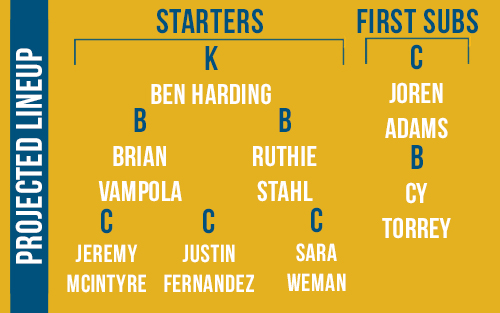 Harding has earned a reputation as one of the West’s best off-ball options for the past two seasons, but he still has a notable distaste for physicality and will sometimes make obvious mistakes when he has the ball and is presented with a skilled point defender. The Blacktips are slowly getting wise to this issue, and making sure the ball is primarily in McIntyre’s hands against physical teams, with Harding acting as a second-touch once he’s positioned to either score or make a solid pass to someone who has positioned themselves near the opposing hoops.
Harding has earned a reputation as one of the West’s best off-ball options for the past two seasons, but he still has a notable distaste for physicality and will sometimes make obvious mistakes when he has the ball and is presented with a skilled point defender. The Blacktips are slowly getting wise to this issue, and making sure the ball is primarily in McIntyre’s hands against physical teams, with Harding acting as a second-touch once he’s positioned to either score or make a solid pass to someone who has positioned themselves near the opposing hoops.
Clever positioning is one of this team’s biggest strengths when it comes to its quaffle players, but it’s also the Blacktips’ most exploitable weaknesses when it comes to their beaters. Their males will often attack opposing bludgered beaters with a bludger of their own on offense in an attempt to retrieve control, but if you beat the Blacktips male beater and your second beater makes a play on the quaffle, you can get an easy turnover that becomes a fast break opportunity. The Blacktips have always struggled with transition defense, and these fast breaks will almost always result in goals.
Seeker Fernandez has been having a fantastic season with Santa Barbara, and the squad justifiably trusts him wholeheartedly in the snitch game. However, that trust can lead to them slacking off on both sides of the ball toward the end of the game, and teams can take advantage of this diminishing effort to unexpectedly pull games out of range. The Blacktips have no true backups for Harding or McIntyre, so if they feel comfortable enough to sub out, teams should take advantage immediately.
Graphics and photo illustration by Amanda Dallas. Original photos by Nicole Harrig (top) and Matt Dwyer (bottom).



